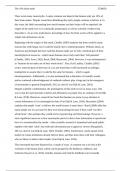The 10% brain myth 2538050
There exists many neuromyths. A quite common one depicts that humans only use 10% of
their brain matter. Despite researchers debunking this myth, people continue to believe it. In
this essay, the fable surrounding how much humans use their brains will be unpacked: the
origins of the myth, how it is continually perpetuated, as well as scientific evidence that
discredits it. As an extra myth-buster, knowledge of how the brain works will be applied to a
simple task all humans can do.
Beginning with the origins of this myth, Chudler (2005) explains that there could be many
reasons this myth began, but it could be mainly due to misinterpretation. William James, an
American psychologist had once said that humans make use of only a minimal part of their
mental/physical resources - which meant humans never truly reach their ‘full potential’
(Chudler, 2005; Arora, 2020; Boyd, 2008; Beyerstein, 2004). However, it was misinterpreted
as “humans do not make use of their whole brain”. Also, Karl Lashley, Chudler (2005)
writes, removed parts of the brain of a rat and found that it still functioned accordingly,
leading him to assume that it would be the same for humans – which is again
misinterpretation. Additionally, it is also mentioned that a distortion of scientific results,
and/or continued acknowledgement of outdated evidence play a huge part in the emergence
of neuromyths in general (Pasquinelli, 2012 as cited in Van Dijk & Lane, 2018).
Despite scientific condemnation, the prolongation of this myth occurs in many ways. One
way is that the myth provides comfort and affirmation to people who are seeking it (Van Dijk
& Lane, 2018). Moreover, research has found that humans are prone to pay attention to
certain information if it is meaningful to them (Van Dijk & Lane, 2018). Beyerstein (2004)
explains that people ‘want’ to believe this myth because it eases them - Boyd (2008) adds that
many people use it to account for their own shortcomings because if they could ‘use their
whole brain’, then perhaps they would not be experiencing said shortcomings. However, a
more significant reason as to how neuromyths persist is due to how information is spread and
how it is sensationalized by media – often scientific research is dramatized and made public
together with other ‘ideal’ but irrelevant information just to appeal to viewers (Pasquinelli,
2012 as cited in Van Dijk & Lane, 2018; Chudler, 2005). Furthermore, myths spread when
leaders in certain institutions already believe them, and thus share them with their colleagues,
who are likely to believe their leaders (Van Dijk & Lane, 2018).
This neuromyth has been disproved in a couple of ways. A common one is to look at the
evolution of the human brain, which can be grouped by the hindbrain, midbrain, and
forebrain (Swartz et al., 2016). Initially, humans only had the hindbrain, but eventually




